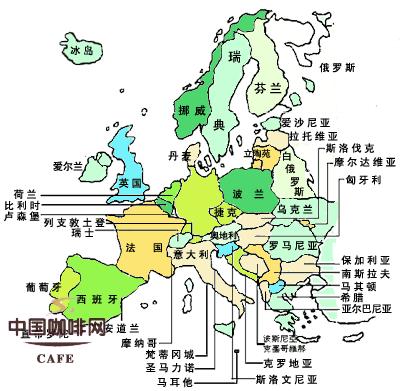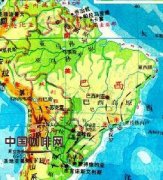Boutique coffee common sense coffee from southern Asia and Oceania
[India (India)]
More than 80% of India's coffee is grown in the southern province of Karnataka, which is often sold under the province's old name "Mysore". The best Myso beans are thought to be Sumatra drunk by the poor and taste as rich and sweet as secondary Sumatra, but at a lower price. Another kind of "rainy season" (Monsooned Malabar) coffee is exposed to the wet monsoon for several weeks, which not only yellowes the beans and reduces the acidity, but also gives the coffee a mature alcohol peculiar to "old Sumatra". It is also suitable for blending comprehensive products.
[Indonesia (Indonesia)]
In contrast to the wine-like taste of Sumatra and East Africa, beans from Indonesia and New Guinea show a different flavor, with a sticky texture, sour taste buried in a complex taste, a dark smell of herbs or wild mushrooms, and a sweet finish that goes deep into the throat for three days. They can play the role of bass in the mix. Many people believe that Mandheling and Ankola, produced in the mountains near Padang in west-central Sumatra, are among the richest textured coffees in the world, of which Manning is more famous and Lindong is the most acclaimed. These beans are semi-washed, that is, they are dried and then washed off with hot water, which makes the beans have the charming earthy smell of dried beans while maintaining neat quality. Aged Sumatra (Aged Sumatra) is a specially treated bean. Raw beans have been stored in the place of origin for three to more than ten years before they are put on the market, which reduces its acidity, reduces its aroma, and makes its taste more round, with a thick texture similar to syrup, thick but not abundant, which can be said to be Pu'er tea in coffee. In the northwestern tip of Sumatra, there is also a kind of washed coffee called Gayo mountain, which is a group of variant trees. It is cleaner and fresher than mantrin and has a clear smell of herbs.
[Sulawesi, Celebes)]
Ravisi's old name is Celebes, and the most common famous coffee is Toraja, which is produced in the center of the island. Toraya is very similar to the first-class Sumatra, except that the texture is slightly less rich, acidity and brightness are also slightly higher, as for the famous wild mushroom flavor and meticulous herbal flavor of Indonesian coffee.

[Java]
In the early 1970s, Java cut down Arabica trees introduced by most Dutch and planted Robbosa beans instead. Since then, Java coffee has become greasy, plain, and has a strong smell of wheat and tea. Of the few remaining Arabica estates, Djampit is the most famous. These beans are similar to other Indonesian beans, but they are more sour and less textured.
[new Guinea (New Guinea)]
The coffee marked New Guinea comes from Papua New Guinea (Papua New Guinea) in the eastern half of the island. The New Guinea bean is also an Indonesian coffee, but it is not as thick as Sumatra, nor the top Celebes sour and fragrant. It is comfortable and smooth, with pleasant acidity and sweetness, and sometimes reminiscent of beef noodles. All beans are carefully treated washed beans, the thickest of the washed Arabica beans, and can be located between Indonesian and Central American coffee. Whether it is used to mix Espresso or general comprehensive products, it can make up for the deficiency of sour coffee.
[Hawaii (Hawaii)]
Kona coffee from Hawaii is grown on the slope of Mount Mauna Loa on the southwest coast of the island of Hawaii. In terms of flavor, the beans are closer to Central American coffee than Indonesian coffee. Its average quality is very high, carefully handled, medium texture, good sour taste, very rich flavor, and the fresh coffee is extremely fragrant. If you think Indonesian coffee is too thick, African coffee is too sour, and Central and South American coffee is too bright, then "but that" may be suitable for you. Because of Hawaii's high wages and many tourists, the coffee is so expensive that it is even sold as "Kona Blend" (no more than 5% of the beans). In recent years, neighboring islands such as Maui, Kauai and Molokai have also begun to grow coffee commercially.
[Taiwan (Taiwan)]
Taiwan is located in the subtropics, the territory is mountainous, and there is an obvious rainy season, so it is a good growing environment for coffee, but since the introduction of coffee trees by the British during Guang Xu's years, the planting scale has not been large. At present, there are still small-scale plantations. There are Huisun Forest Farm in Nantou Mountain area (more than 1,000 meters above sea level), Hebao Mountain in Yunlin Ancient Keng (294 meters above sea level), Kenting Park (above Arabica species), Department of Horticulture of National Taiwan University, Chiayi Agricultural Experimental Institute (above Liberia species) and Provincial Forestry Experimental Institute Heng the Spring Equinox (both). The coffee bean flavor of Hebao Mountain is similar to that of Central and South American beans, with a soft sour taste.
Important Notice :
前街咖啡 FrontStreet Coffee has moved to new addredd:
FrontStreet Coffee Address: 315,Donghua East Road,GuangZhou
Tel:020 38364473
- Prev

Basic knowledge of Fine Coffee International Coffee Organization
The International Coffee Organization is an intergovernmental organization founded in London in 1963. It is composed of coffee importers and exporters. The organization is responsible for implementing the International Coffee Convention and is committed to improving the situation of the world coffee industry through international cooperation. The establishment of the International Coffee Organization is based on the irreplaceable economic importance of coffee. Coffee is one of the most traded goods in the world.
- Next

Coffee in South America
[Colombia] is the world's second-largest coffee producer, accounting for about 12% of the world's annual production, although much lower than the 30 to 35% of Brazil, most of which are high-quality alpine washed beans. Central Colombia is divided into several valleys by three north-south vertical mountains, of which the central and eastern mountains are the main coffee producing areas. Coffee here is named after the market of distribution,
Related
- Beginners will see the "Coffee pull flower" guide!
- What is the difference between ice blog purified milk and ordinary milk coffee?
- Why is the Philippines the largest producer of crops in Liberia?
- For coffee extraction, should the fine powder be retained?
- How does extracted espresso fill pressed powder? How much strength does it take to press the powder?
- How to make jasmine cold extract coffee? Is the jasmine + latte good?
- Will this little toy really make the coffee taste better? How does Lily Drip affect coffee extraction?
- Will the action of slapping the filter cup also affect coffee extraction?
- What's the difference between powder-to-water ratio and powder-to-liquid ratio?
- What is the Ethiopian local species? What does it have to do with Heirloom native species?

